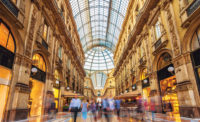The Importance of "Design Thinking" for Package Design

The term “decoration” has long been used for the visual aspect of packaging. But at MSLK, we’ve found that this arcane expression represents everything wrong with the old way of thinking – that design is merely a façade to spice up the package. If a brand views design as only the exterior of their packaging, they’re likely missing out on the deeper connection design has to a brand. Good design can inform the entire process of production – from the formulation, presentation at retail, through to the essence of the brand.
Too often we see great packaging containing lousy products and vice versa. It seems as if the people making the product have never spoken to the people designing the packaging. Why is there a disconnect between the product and the package? Often, there is a reluctance to deviate from processes that have been ins place for decades.
We suggest a holistic approach to design thinking. The goal is to create a cohesive brand that relays its message to consumers. This holistic approach begins with the design team, who ask critical questions and innovate with experts from all areas, including R&D, product development, manufacturing, and sales. Having access to all key decision makers and influencers, the design team coordinates efforts to create a seamless product.
Below are a few of the questions we like to ask before beginning any packaging design assignment to ensure all avenues for a successful design process are explored.
Is the Consumer Your Priority?
“It’s never about you; it’s always about them,” is a mantra we repeat to our clients. From a consumer’s perspective, great design translates to an articulate, smooth, and joyful encounter. Brands must remain flexible and anticipate their customer’s needs. When a brand finds success with one hero product, there must be an immediate anticipation of the consumer’s “I love it! What’s next?” reaction. Always be ready for a “next step” product, as this will prevent a disconnect between the brand’s promise and the reality of the user’s experience. We may ask our clients to add additional SKUs into their product assortment to make regimens clearer or to support their brand presence in a specific product category.
The overall design of a line’s brand architecture has everything to do with the way the brand anticipates the consumer will shop. In the beauty industry, some products may be designated by key ingredient, by step in the regimen, by skin or hair type, by efficacy level (basic vs. pro) or by user benefit. Wise brands choose one main approach and stick with it throughout their entire line, instead of reinventing a new system each time, as this only leads to consumer confusion.
While there’s no consistent answer to the number of products a brand should offer, too few SKUs means there are not enough choices, and too many SKUs can be overwhelming. Whatever the case, you must think strategically like a designer and take a hard look at how new products fall into the larger picture of your offerings. Sometimes, this may even include creating sets and POP displays that position a new product into a new category.
What is Your Unique Product Experience?
If your formulation is designed to be the most effective on the market, your packaging must use all the tools available to convey this: color, images, materials, words, etc. Packaging components make the user further realize that the product is well-designed. If you are trying to suggest convenience, the packaging should be easy to use. If you are trying to convey luxury, then your packaging should be lavish to the touch. Brand architecture, formulation, and packaging must work together to deliver on the brand promises.
Is Your Brand Story Clear?
Most companies are likely to rush the design process because they’re too caught up in the scramble to innovate their products. Many brands fear losing control to the creative team, as they are often viewed as wasting time and money. But design has the power to reinforce the brand story in ways that words alone cannot. An unhurried and holistic view of design should be your brand’s top priority.
All customers will see and interact with your packaging. The holistic approach to design will make that packaging effective. The result will be a brand that beckons shoppers from afar with clear, beautiful packaging. Consumers will become intrigued with other offerings from your product line. At home, they will find that the experience of the item delivered the promise of the packaging. The consumer will then become a fan, and actively seek out your brand in the future.
Keep This in Mind
If you and your team are still questioning the greater value of design and design thinking, consider this: one hundred percent of your customers will handle your packaging. They may never see your advertising or visit your website, but they will look at your packaging, which should be the distillation of your entire brand story and experience. Every investment you’ve made in your brand depends on the magical moment your customer encounters your packaging for the first time. How can you afford not to invest in clever ideas and exceptional design?
Looking for a reprint of this article?
From high-res PDFs to custom plaques, order your copy today!




